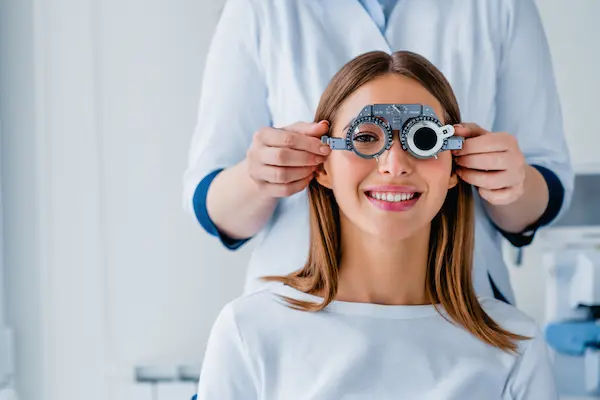How Can Squint Be Corrected? A Complete Guide to Treatment Options
Learn how squint (strabismus) can be corrected. Our comprehensive guide covers the causes, symptoms, and various treatment options, including exercises, glasses, and surgery.

Written by Dr. Dhankecha Mayank Dineshbhai
Reviewed by Dr. M L Ezhilarasan MBBS
Last updated on 10th Sep, 2025

Have you or your child been diagnosed with a squint, or do you suspect one? You're not alone. A squint, medically known as strabismus, is a common condition where the eyes point in different directions, affecting both children and adults. It's more than just a cosmetic concern; it can impact vision, depth perception, and confidence. The good news is that modern medicine offers highly effective ways to correct it. This comprehensive guide will walk you through everything you need to know—from what causes a squint to the full range of nonsurgical squint treatment options and surgical procedures. We'll demystify the process, explain the goals of treatment, and help you understand what to expect on the journey to better aligned eyes and clearer vision.
What Exactly is a Squint (Strabismus)?
A squint occurs when there is an imbalance in the muscles that control eye movement, preventing them from working together as a team. This misalignment means that while one eye looks directly at an object, the other may turn inward (esotropia), outward (exotropia), upward (hypertropia), or downward (hypotropia). This misalignment can be constant or intermittent, appearing only when a person is tired, ill, or focusing on a nearby object.
Consult a Ophthalmologist for the best advice
Understanding the Different Types of Squint
Knowing the type of squint is the first step toward effective correction. The main categories are:
- Esotropia: The eye turns inward toward the nose. This is one of the most common types, especially in infants.
- Exotropia: The eye turns outward, away from the nose. This often begins intermittently, especially when looking at distant objects or daydreaming.
- Hypertropia & Hypotropia: These are less common and involve one eye being higher (hypertropia) or lower (hypotropia) than the other.
Why Correcting a Squint is Crucial: Beyond Cosmetics?
Many people seek treatment for aesthetic reasons, but the functional benefits are far more critical. Untreated strabismus can lead to several serious complications.
The Risk of Amblyopia (Lazy Eye)
- In young children, the brain receives two different images due to the misalignment. To avoid double vision and confusion, the brain learns to ignore the signal from the misaligned eye. This leads to a failure to develop normal vision in that eye, a condition known as amblyopia or lazy eye. If not treated early during the critical period of visual development (usually before age 79), the vision loss can become permanent.
Impact on Depth Perception and Coordination
- Proper depth perception (stereopsis) requires both eyes to aim at the same target. A squint disrupts this coordinated effort, making it difficult to judge distances. This can affect a child's ability to catch a ball, navigate stairs, or even learn to read. In adults, it can impact driving and certain professions.
Psychological and Social Considerations
- The visible nature of a squint can subject both children and adults to teasing, social anxiety, and low self-esteem. Correcting the alignment can significantly boost confidence and improve social interactions.
The First Step: How is Squint Diagnosed?
A proper diagnosis is essential for determining the correct course of treatment. If you notice any signs of misalignment, a comprehensive eye exam is necessary.
The Comprehensive Eye Examination
- An eye care specialist will begin with a detailed history and a standard eye test to check for refractive errors like nearsightedness, farsightedness, or astigmatism, which can contribute to a squint.
Specialized Tests for Strabismus
- The doctor will perform specific tests to assess the alignment and focusing ability of your eyes. These include the cover test (covering and uncovering each eye to see how they move), the Hirschberg test (shining a light at the eyes to see its reflection on the cornea), and tests for depth perception.
NonSurgical Squint Correction Methods
For many patients, squint can be corrected without surgery through various conservative approaches. The chosen method depends on the type and cause of the squint.
Corrective Eyewear: The Simplest Solution for Some
- If the squint is caused by a significant refractive error (e.g., severe farsightedness), prescription glasses or contact lenses can often correct the alignment by helping the eyes focus properly with less effort, allowing them to work together.
Patching Therapy: Strengthening the Weaker Eye
- If amblyopia has developed, patching the stronger eye is a standard treatment. This forces the brain to use the weaker ("lazy") eye, strengthening its visual pathway and improving sight. Consistency is key to the success of this therapy.
Vision Therapy: Exercises for Your Eye Muscles
- Vision therapy for strabismus involves a customized program of eye exercises designed to improve coordination, focusing ability, and eye teaming. It can be particularly effective for intermittent exotropia and convergence insufficiency (a type of esotropia that makes nearfocused work difficult).
Botox Injections: A Minimally Invasive Option
- In some cases, Botulinum toxin (Botox) can be injected into the overactive eye muscle. This temporarily weakens the muscle, allowing the opposing muscle to tighten and pull the eye into a better position. It's often used for small angle squints or as a temporary measure before deciding on surgery.
Squint Surgery: Correcting the Eye Muscles
- When nonsurgical methods are insufficient, squint surgery is a highly successful option to physically correct the alignment.
When is Squint Surgery Recommended?
Surgery is typically recommended for largeangle, constant squints that cannot be corrected with glasses or therapy. It's also an option for adults who wish to correct a longstanding squint for cosmetic and functional reasons.
What to Expect During the Procedure
The surgery involves adjusting the tension on one or more of the six muscles attached to each eye. The surgeon may weaken a muscle by recessing it (moving it backward) or strengthen it by resecting it (shortening it). The procedure is usually done under general anesthesia for children and local for adults, and it typically takes about 12 hours.
Recovery and Results After Strabismus Surgery
- Recovery is relatively quick. The eyes will be red and sore for a few days to a week. Most people can return to school or work within a week. While the cosmetic result is often immediate, the brain may take some time to adapt to the new alignment. In some cases, more than one surgery may be needed to achieve perfect alignment. Is squint surgery safe? Yes, it is a common and safe procedure with a high success rate, though, like any surgery, it carries minimal risks like infection or over/undercorrection.
Treatment for Squint in Adults vs. Children
- The approach to correction differs by age. In children, the primary goal is to preserve and develop binocular vision. Treatment is often more urgent. For adults, the goal may be to eliminate double vision or correct a misalignment for cosmetic improvement. While the brain's plasticity is lower in adults, squint correction in adults is still very possible and can be life changing. If you've lived with a squint into adulthood, consult a doctor online with Apollo24|7 to discuss your options for improvement.
Key Takeaways for Squint Correction
- Early Intervention is Key: Especially in children, early diagnosis and treatment are crucial to prevent permanent vision loss from amblyopia.
- It's More Than Cosmetic: Treatment is essential for developing proper binocular vision, depth perception, and confidence.
- Multiple Options Exist: Correction ranges from noninvasive methods like glasses, patching, and vision therapy to surgical intervention.
- A Professional Diagnosis is Essential: Only an eye specialist can determine the type and cause of your squint and recommend the correct treatment path.
- Treatment is Effective: Whether for a child or an adult, modern treatments for strabismus are highly successful in improving alignment and vision.
Conclusion
Living with a squint can present challenges, but it's important to know that effective solutions are readily available. The journey to correction begins with a professional diagnosis to understand the root cause of the misalignment. From there, a tailored plan—whether it involves eye exercises, corrective lenses, or strabismus surgery—can be developed to straighten the eyes and restore visual function. The most critical step is taking action. Don't assume a squint will correct itself, especially in a child. If you have any concerns about your own eye alignment or your child's, seeking expert advice is the best decision you can make for long-term eye health and quality of life. If your condition does not improve after trying conservative methods, or if you want to explore surgical options, book a physical visit to a doctor with Apollo24|7 to get a comprehensive evaluation and personalized treatment plan.
Consult a Ophthalmologist
Consult a Ophthalmologist

Dr. Pratik Ranjan Sen
Ophthalmologist
20 Years • MBBS; MS; DO
Chennai
Apollo Hospitals Greams Road, Chennai
(25+ Patients)

Dr. Shivani Grover
Ophthalmologist
9 Years • MS (Ophthalmology), Fellowship Cataract, Squint & Paediatric Ophthalmology
Lucknow
Apollomedics Super Speciality Hospital, Lucknow

Dr. Arpita Agrawal
Ophthalmologist
20 Years • MBBS MS FLUPEI
Bhopal
Apollo Sage Hospitals, Bhopal

Dr Monica Gour
Ophthalmologist
9 Years • MS(Ophthalmology) Fellowship in Cornea
Lucknow
Apollomedics Super Speciality Hospital, Lucknow

Dr. Sharon Dsouza
Ophthalmologist
15 Years • MBBS,MS in Ophthalmology ,Fellowship – Cornea & Refractive Surgery ,PhD in Ocular Immunology
Bengaluru
Apollo Hospitals Bannerghatta Road, Bengaluru
Consult a Ophthalmologist for the best advice

Dr. Pratik Ranjan Sen
Ophthalmologist
20 Years • MBBS; MS; DO
Chennai
Apollo Hospitals Greams Road, Chennai
(25+ Patients)

Dr. Shivani Grover
Ophthalmologist
9 Years • MS (Ophthalmology), Fellowship Cataract, Squint & Paediatric Ophthalmology
Lucknow
Apollomedics Super Speciality Hospital, Lucknow

Dr. Arpita Agrawal
Ophthalmologist
20 Years • MBBS MS FLUPEI
Bhopal
Apollo Sage Hospitals, Bhopal

Dr Monica Gour
Ophthalmologist
9 Years • MS(Ophthalmology) Fellowship in Cornea
Lucknow
Apollomedics Super Speciality Hospital, Lucknow

Dr. Sharon Dsouza
Ophthalmologist
15 Years • MBBS,MS in Ophthalmology ,Fellowship – Cornea & Refractive Surgery ,PhD in Ocular Immunology
Bengaluru
Apollo Hospitals Bannerghatta Road, Bengaluru
More articles from Strabismus
Frequently Asked Questions
Can squint be corrected with exercises alone?
For certain types of squint, like convergence insufficiency, vision therapy exercises can be very effective. However, for constant, large angle squints, exercises alone are usually not sufficient and are often used in conjunction with other treatments like glasses or surgery.
What is the best age for squint surgery?
There is no single 'best' age. Surgery is performed when it is medically necessary, which can be as young as a few months old for congenital squints, or at any age in adulthood. The timing depends on the type and severity of the squint.
Will my child need glasses after squint surgery?
Yes, if your child needed glasses before surgery due to a refractive error, they will almost certainly still need them after surgery. Surgery corrects the muscle alignment, not the underlying focusing problem.
Is squint a sign of a serious medical condition?
While most squints are isolated problems with the eye muscles, a sudden onset of squint in an older child or adult can sometimes indicate a more serious neurological condition. It is essential to get any new squint evaluated promptly by a doctor.
Can a squint come back after treatment?
Recurrence is possible, especially in children as they grow. This is why followup appointments with the eye doctor are crucial, even after successful treatment, to monitor alignment and vision.


.webp)